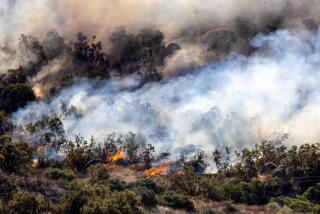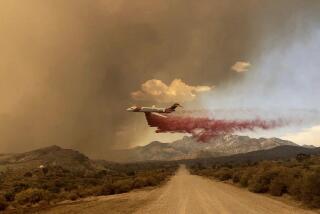Rim fire spreading more slowly; containment expected in 2 weeks
The rate of spread of the massive Rim fire near Yosemite National Park has slowed in recent days and firefighters expect to have it fully contained by Sept. 10, officials said.
Firefighters’ efforts are aided by cooler weather, higher relative humidity and lighter winds, said Cal Fire spokesman Daniel Berlant.
“That’s given us a greater opportunity to get in there and strengthen our containment lines,” he told The Times.
PHOTOS: Rim fire rages into Yosemitie
He said fire commanders expect full containment of the blaze in the next two weeks.
Last week, the fire burned 30,000 acres in a 24-hour span and 50,000 acres in another 24-hour span, Berlant said. But in the last two days, the rate of fire spread has slowed to 10,000 acres one day and 5,000 on another.
The Rim fire has ravaged more than 187,000 acres of brush and timber and was 23% contained. The fire had charred more than 40,000 acres in Yosemite National Park.
At least 111 structures have been destroyed by the fire, which has been burning since Aug. 17.
Fire crews in Yosemite were hoping to slow advancing flames by conducting large-scale backfire operations from Hetch Hetchy Reservoir south to Tioga Road.
The dangerous tactic involves setting fires inside containment lines to burn vegetation in the path of advancing flames and stop the spread of the blaze.
They are also using an unmanned drone aircraft that provides real-time imagery to give fire commanders a birds-eye view of the 300-square-mile blaze.
Incident Cmdr. Mike Wilkins requested the MQ-1 aircraft belonging to the California Air National Guard. The remotely piloted plane began flying Wednesday morning. It continued on a 20-hour mission throughout the day, alerting crews to a spot fire and providing a more comprehensive fire map.
The drone, about the size of a small Cessna plane, takes off from the Victorville Airport and is operated from March Air Reserve Base in Riverside, said Lt. Col. Tom Keegan of the National Guard.
Unmanned aircraft have been used sparingly on fires but are gaining traction as a cheaper, more efficient tool for fire bosses to better understand where fires are going and how they are behaving.
They are especially prized for their ability to beam real-time pictures directly to fire bosses, who can make tactical adjustments more quickly. The aircraft are equipped with infared heat sensors and a swiveling camera operated by a remote pilot.
Unlike fixed-wing planes and helicopters, drones are not grounded at night or unable to fly in high winds or smoke. They fly at about 18,000 feet and cost about $800 an hour to operate, Keegan said.
ALSO:
Los Angeles moves to lift decade-old ban on public murals
Hannah Anderson kidnap suspect’s sister: ‘Very difficult to believe’
Two women found dead in O.C. apartment, no visible signs of trauma
robert.lopez@latimes.com
Twitter: @LAJourno
julie.cart@latimes.com
Twitter: @julie_cart
More to Read
Start your day right
Sign up for Essential California for news, features and recommendations from the L.A. Times and beyond in your inbox six days a week.
You may occasionally receive promotional content from the Los Angeles Times.








